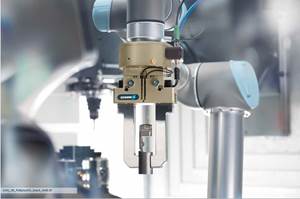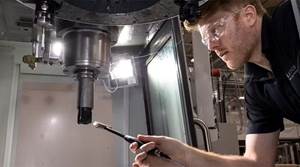Integrating Additive Manufacturing without Inhibiting Machining
CNC machining is the superior process for dimensional precision. Can AM be added to the machine tool without compromising this strength?
Share






Mitsui Seiki is a machine tool builder that aims to excel in the area of precision. It provides machines, often custom-engineered, to meet machining challenges related to high-value parts with particularly demanding tolerances. Therefore, the company’s introduction of additive manufacturing as a capability it can now deliver might seem like an odd fit. Additive manufacturing—building up parts or features through a controlled process of adding material in layers—cannot by itself achieve anything like the fine tolerances that machining can.
But Robb Hudson, technology and business development manager for the company, says additive manufacturing is an addition to machining that brings both design freedom and process efficiency to complement machining’s precision. And by consolidating more of a part’s processing into a single machine, it potentially reduces part handling, which facilitates precision as well. During the past year or more that the company has been preparing to come to market with additive capability, he says, it has been experimenting with how to use metal cutting and metal deposition effectively within the same machine tool, without having to compromise the effectiveness or promise of either capability.
Mr. Hudson says essentially any of the company’s machines can now be made available as a hybrid system, capable of both additive and subtractive operations. A hybrid model of the company’s Vertex five-axis machining center will now be a standard product. The additive capability comes from the company’s partnership with Hybrid Manufacturing Technologies, a firm jointly based in Texas and the UK that offers a system for integrating additive manufacturing capability into an existing machine tool. The Hybrid head performs metal additive manufacturing through laser cladding, feeding metal powder into a pool that is melted by a laser. The head mounts in the machine’s spindle using a toolholder, and when it is not in use, it waits in the machine’s carousel alongside other tools.
A hybrid additive/subtractive version of this machining center is now available as a standard product, but the company says essentially any of its machines can now be made available as hybrids.
Yet integrating additive capability into the machine is not as simple as adding this head. The machine itself is also modified for safe use of the laser, as well as to enable powder flow. And if the full machining capabilities are to remain available, then new processing techniques along with other machine modifications are in order, too.
For example, what about coolant? Generally, coolant and lasers don’t mix, Mr. Hudson observes. But as part of the testing of additive/subtractive processing at Mitsui Seiki’s headquarters in Japan, the company has refined a process for using flood coolant extensively within a cycle that also includes additive layering. In this process, an air blow-off operation removes much of the volume of coolant still clinging to the part, followed by the laser applied at a wide focus to evaporate the rest. The surface dried in this way is ready for a new feature to be grown onto it through laser cladding.
A similarly important consideration is protection of the machine. Because some metal powder invariably escapes, preserving the machining precision demands ensuring that the powder does not affect sensitive mechanical systems such as the ballscrews and ways. Here, the company was able to draw on extensive prior experience, Mr. Hudson says. Guarding and other kinematic protections the company has engineered for machining centers used in precision graphite milling have been adapted to protecting the machine against metal powder.
The reward for all of this development will be the opportunity to deliver much more manufacturing capability within a single cycle, and bring much more of a part’s production into a single machine. CNC machining is the solution for tight precision, while additive manufacturing is potentially the solution where a high level of geometric complexity is needed. Those two benefits need not be separate—a part that includes geometrically challenging features is now also a part that can be machined to tight tolerances, without any handling or travel needed to transition between those objectives.
Indeed, that promise is particularly beneficial to manufacturers in the aerospace industry, Mr. Hudson says. A large portion of the machine tool builder’s customers are in this sector. “Their aim is often the buy-to-fly ratio, or how much material they have to purchase versus how much is left once all of the part’s machining is done,” he says. Buy-to-fly ratios are often high to machine elaborate aircraft components out of solid billet or even out of forgings, meaning material waste is high. But hybrid manufacturing offers a solution here as well. That is, instead of an oversize workpiece going into the machine to get much of its material cut away, what if a workpiece that was actually incomplete went into the machine instead? For material efficiency, some of this part’s features would still be produced through machining, while other features—narrow fins and other projections, for example—could instead be produced cost-effectively by additively building them on.
Related Content
6 Machine Shop Essentials to Stay Competitive
If you want to streamline production and be competitive in the industry, you will need far more than a standard three-axis CNC mill or two-axis CNC lathe and a few measuring tools.
Read MoreLean Approach to Automated Machine Tending Delivers Quicker Paths to Success
Almost any shop can automate at least some of its production, even in low-volume, high-mix applications. The key to getting started is finding the simplest solutions that fit your requirements. It helps to work with an automation partner that understands your needs.
Read More4 Commonly Misapplied CNC Features
Misapplication of these important CNC features will result in wasted time, wasted or duplicated effort and/or wasted material.
Read MoreHow to Mitigate Chatter to Boost Machining Rates
There are usually better solutions to chatter than just reducing the feed rate. Through vibration analysis, the chatter problem can be solved, enabling much higher metal removal rates, better quality and longer tool life.
Read MoreRead Next
AMRs Are Moving Into Manufacturing: 4 Considerations for Implementation
AMRs can provide a flexible, easy-to-use automation platform so long as manufacturers choose a suitable task and prepare their facilities.
Read MoreMachine Shop MBA
Making Chips and 91ÊÓƵÍøÕ¾ÎÛ are teaming up for a new podcast series called Machine Shop MBA—designed to help manufacturers measure their success against the industry’s best. Through the lens of the Top Shops benchmarking program, the series explores the KPIs that set high-performing shops apart, from machine utilization and first-pass yield to employee engagement and revenue per employee.
Read MoreLast Chance! 2025 Top Shops Benchmarking Survey Still Open Through April 30
Don’t miss out! 91ÊÓƵÍøÕ¾ÎÛ's Top Shops Benchmarking Survey is still open — but not for long. This is your last chance to a receive free, customized benchmarking report that includes actionable feedback across several shopfloor and business metrics.
Read More





















